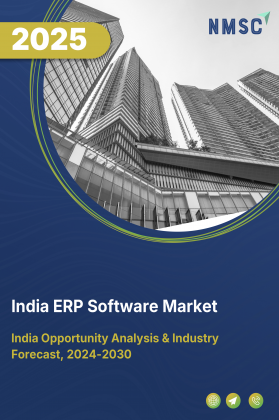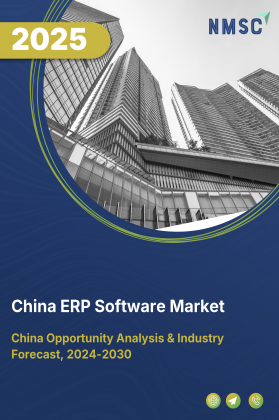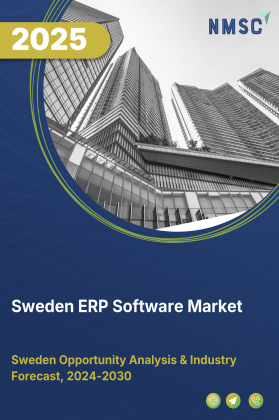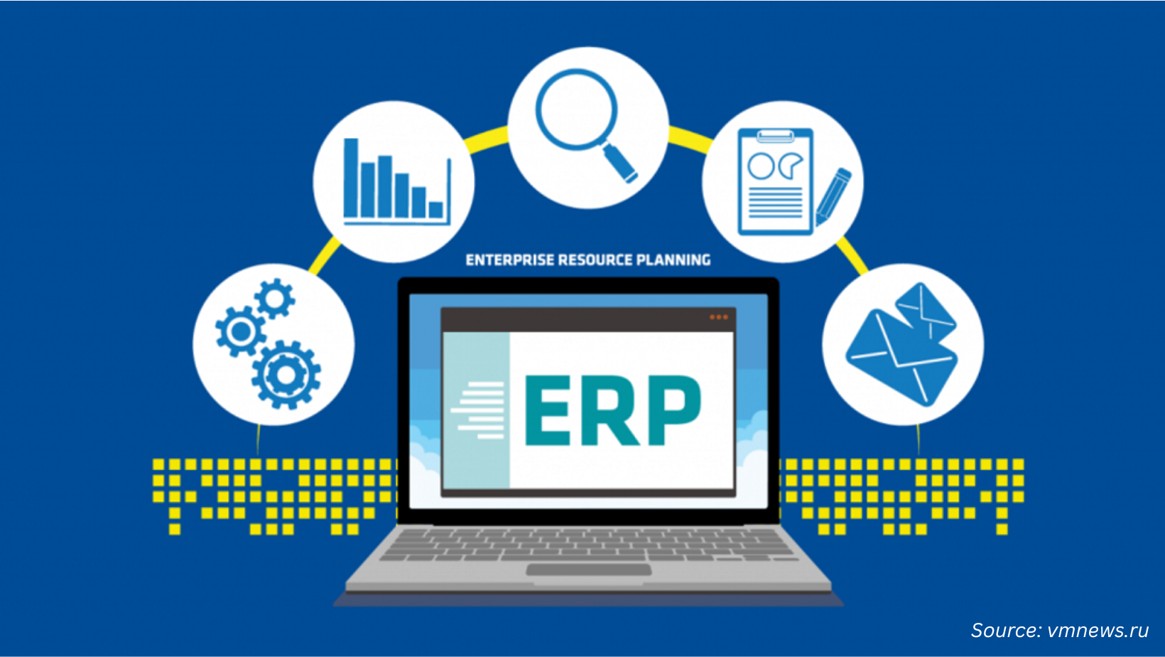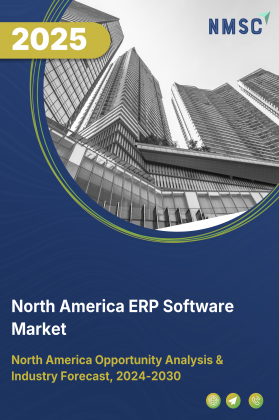
North America ERP Software Market by Component (Software, and Services), Deployment (On-Premise, Cloud, and Hybrid), Business Function (Enterprise Asset Management, Financial Management, Human Capital Management, and Others), Application (Manufacturing, BFSI, Healthcare, Retail & Distribution, Government, IT & Telecom, and Others), and End Users (Small & Medium Enterprises, and Large Enterprises) – Trends and Forecast, 2025–2030.
Industry: ICT & Media | Publish Date: 17-Oct-2025 | No of Pages: N/A | No. of Tables: N/A | No. of Figures: N/A | Format: PDF | Report Code : IC3605
Industry Outlook
The North America ERP Software Market size was valued at USD 38.20 billion in 2024 and is projected to grow to USD 43.32 billion by 2025. Additionally, the industry is expected to continue its growth trajectory, reaching USD 60.08 billion by 2030, with a CAGR of 6.76% from 2025 to 2030.
The market is experiencing strong growth, driven by continuous innovation from major vendors like SAP, Oracle, Microsoft Dynamics 365, and Opkey, who are introducing scalable, AI-powered solutions tailored to market needs. In Canada, the rapid rise of e-commerce is boosting ERP demand, particularly in retail and distribution, as businesses seek real-time analytics and automation to streamline operations. However, SMEs face ongoing challenges integrating ERP systems due to high costs, complex customization, and limited technical expertise. Despite these hurdles, IoT integration is emerging as a game changer, enabling real-time monitoring and predictive capabilities that significantly enhance ERP functionality and open new opportunities across manufacturing and logistics.
Key ERP Vendors Drive Innovation and Market Growth
The presence of major ERP vendors such as SAP, Oracle, Microsoft Dynamics 365, Opkey, and others significantly accelerates the growth of the ERP software market in North America. These market leaders are at the forefront of innovation, offering scalable, industry-specific solutions that cater to the evolving needs of modern enterprises. In February 2025, Opkey launched its ERP Lifecycle Optimization Platform, powered by its proprietary small language model, Argus AI. This platform features agentic AI-driven virtual agents, Configuration, Testing, Training, and Support Agents that automate complex ERP processes, reducing costs by up to 50% and testing time by 85%. In the same month, Clients First, a leading partner of Microsoft Dynamics 365 and Acumatica, unveiled a redesigned website aimed at improving access to modern ERP solutions for growing businesses. Key players' continuous innovations and proactive strategies are driving broader ERP adoption across industries and sustaining the momentum of market development in the U.S.
Accelerating E-Commerce Drives Increase in ERP Market Expansion
The rapid growth of retail and distribution industry, especially through e-commerce, is fueling a significant rise in demand for Enterprise Resource Planning (ERP) systems. In 2022, over 27 million netizens of Canada, about 75% of the population, engaged in e-commerce, with projections expecting this to reach 77.6% by the end of 2025, according to the U.S. International Trade Administration. This surge in online shopping creates a critical need for powerful ERP solutions to efficiently handle complex processes such as inventory management, logistics, and customer service. By offering real-time data analytics and automation, ERP systems help retailers streamline supply chains and deliver fast, reliable service. As a result, the expanding e-commerce market in Canada is a major factor driving the widespread adoption of ERP software within the retail and distribution sectors.
Technical and Financial Barriers Hinder ERP Integration for Smaller Enterprises
Despite strong market momentum, integrating ERP systems with legacy infrastructure remains a key obstacle, particularly for SMEs. High customization costs, complex implementation processes, and a shortage of skilled ERP professionals hinder seamless adoption. For many smaller enterprises, these barriers result in long deployment timelines and underutilization of advanced features. While government programs aim to ease financial constraints, technical limitations continue to slow adoption rates, affecting the broader pace of digital transformation across the region.
IoT-Driven ERP Solutions Expand Operational Efficiency and Market Opportunities
The integration of Internet of Things (IoT) technology with ERP systems is becoming a key catalyst for growth, offering enhanced real-time data visibility and improved operational control. IoT-enabled ERP platforms allow businesses to efficiently track inventory, monitor equipment conditions, and anticipate maintenance needs, significantly boosting performance in industries like manufacturing and logistics. A notable example is the March 2025 launch of Epicor Kinetic 2025 by Epicor Software Corporation, a next-generation ERP solution featuring advanced IoT capabilities for real-time monitoring and predictive maintenance in manufacturing settings. This development underscores the transformative role of IoT in enhancing ERP functionalities and reflects the increasing market demand for intelligent, connected enterprise solutions.
US Holds More Than 70% of Market Share in North America
The United States leads the North America ERP software market trends, driven by its robust technological infrastructure and high level of enterprise digitalization. The growth of the U.S. manufacturing sector is playing a key role in accelerating the adoption of ERP solutions. According to the National Association of Manufacturers (NAM), as of Q4 2024, manufacturing contributed USD 2.94 trillion to the U.S. economy, representing 10.0% of the national GDP.
The sector employs over 13 million individuals across more than 244,000 establishments, with 74% of these firms having fewer than 20 employees. This significant growth underscores the need for advanced ERP systems to manage complex operations, enhance supply chain efficiency, and comply with regulatory standards. Additionally, the increasing demand for real-time analytics and integration with emerging technologies such as AI and IoT further highlights the critical role of ERP solutions in strengthening the competitiveness of the manufacturing industry.
Canada to Witness Highest CAGR of 8.82% in North America
Canada holds the second-highest position in the North American ERP software market share, with the fastest growth rate in the region. Government initiatives are playing a crucial role in driving this growth by providing financial support to small and medium-sized enterprises (SMEs) aiming to modernize their operations. Programs such as the National Research Council of Canada Industrial Research Assistance Program (NRC IRAP) offer grants covering up to 80% of direct labor costs and 75% of subcontractor fees, up to a maximum of USD 100,000, to support ERP implementation. Additionally, the Canada Small Business Financing Program (CSBFP) provides low-interest loans of up to USD 1.15 million, with up to USD 150,000 available for intangible assets, including ERP software. These initiatives reduce financial barriers and enable SMEs to adopt ERP solutions that improve operational efficiency, regulatory compliance, and competitiveness, thereby accelerating the overall growth of the ERP market in Canada.
Competitive Landscape
The market players operating in the North America ERP software industry include SAP SE, Microsoft Corporation, Oracle NetSuite, Sage Group plc, Workday, Inc., Odoo, Epicor Software Corp., Infor, Xero Ltd, Aptean, Deltek, Inc., Unit4, Ramco Systems, Rockwell Automation, Acumatica. and others.
North America ERP Software Market Key Segments
By Component
-
Software
-
Service
By Deployment
-
On Premise
-
Cloud
-
Hybrid
By Business Function
-
Enterprise Asset Management (EAM)
-
Record Assets (Asset Mgmt)
-
Analytics & BI
-
Disposal of Assets
-
Others
-
-
Financial Management System
-
Core Financials
-
Corporate Performance Mgmt (CPM)
-
Financial Consolidation
-
Others
-
-
Human Capital Management (HCM)
-
Talent Management
-
Administrative HR
-
Workforce Management
-
Others
-
-
Manufacturing and Operations
-
Production Planning and Scheduling Products
-
Production Ops and Control Products
-
Manufacturing Information Mgmt Products
-
Others
-
-
Supply Chain Management (SCM)
-
Inventory management
-
Warehouse management
-
Transportation management
-
Procurement
-
Contract Management
-
-
Others
By Application
-
Manufacturing
-
BFSI
-
Healthcare
-
Retail & Distribution
-
Government
-
IT & Telecom
-
Construction
-
Aerospace Defense
-
Other Industries
By End Users
-
Small and Medium-Sized Enterprise
-
Large Enterprise
By Country
-
The U.S.
-
Canada
-
Mexico
Key Players
-
SAP SE
-
Microsoft Corporation
-
Oracle NetSuite
-
Sage Group plc
-
Workday, Inc.
-
Odoo
-
Epicore software corp.
-
Infor
-
Xero Ltd
-
Aptean
-
Deltek, Inc.
-
Unit4
-
Ramco system
-
Rockwell Automation
-
Acumatica
Report Scope and Segmentation
|
Parameters |
Details |
|
Market Size in 2025 |
USD 43.32 Billion |
|
Revenue Forecast in 2030 |
USD 60.08 Billion |
|
Growth Rate |
CAGR of 6.76% from 2025 to 2030 |
|
Analysis Period |
2024–2030 |
|
Base Year Considered |
2024 |
|
Forecast Period |
2025–2030 |
|
Market Size Estimation |
Billion (USD) |
|
Growth Factors |
|
|
Countries Covered |
03 |
|
Companies Profiled |
15 |
|
Market Share |
Available for 10 companies |
|
Customization Scope |
Free customization (equivalent up to 80 working hours of analysts) after purchase. Addition or alteration to country, regional, and segment scope. |
|
Pricing and Purchase Options |
Avail customized purchase options to meet your exact research needs. |

















 Speak to Our Analyst
Speak to Our Analyst



